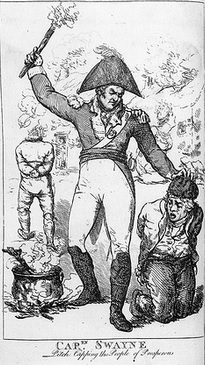Irish Legal Heritage: Pitchcapping

Illustration of Captain Swayne
pitchcapping the people of
Prosperous, Co. Kildare
(The Irish Magazine, February 1810)
Seosamh Gráinséir, writing for “Irish Legal Heritage” in our sister publication Irish Legal News, reflects on ‘pitchcapping’, a gruesome practice which may interest readers in Scotland.
During the United Irishman Rebellion of 1798, one of the forms of torture used by the British on suspected Irish rebels – or “Croppies” – was pitchcapping. Victims were subjected to “caps” full of boiling tar, or “pitch”, and gunpowder, forced on their heads and set alight.
If the victims were not killed in the process of pitchcapping, they were often scalped by the removal of the cooled pitchcap, and left blind by the hot tar running into their eyes. Described as having a “personal vendetta against the system of disaffection” (Corrigan, 1997), Captain Richard Longford of Swayne was one famous enthusiast of this method of torture, and his propensity to torture the people of Prosperous, Co. Kildare is illustrated in the picture above.
Another yeoman who was said to have “perfected the pitchcap torture” was Sergeant Thomas Honam. Said to be the original ‘Tom the Divil’ (Furlong, 1991), Tom and his militia were permitted to “seize every man they wished or chose to suspect as a Croppy, and drag him to the guardhouse” to be tortured (Cusack, 1868). Indeed Furlong’s account of pitchcapping describes how in some cases, Tom and his militia would unbind the victim’s feet to enjoy the “spectacle of them running around in agony, and in some cases, deliberately smashing their own heads in an attempt to end the torment” (Furlong, 1991).
Seosamh Gráinséir








